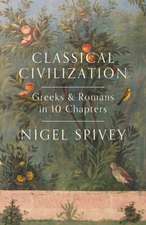Early New World Monumentality
Editat de Richard L. Burger, Robert M. Rosenswigen Limba Engleză Paperback – 31 mai 2015
Preț: 322.80 lei
Nou
Puncte Express: 484
Preț estimativ în valută:
61.77€ • 64.66$ • 51.11£
61.77€ • 64.66$ • 51.11£
Carte tipărită la comandă
Livrare economică 05-19 aprilie
Preluare comenzi: 021 569.72.76
Specificații
ISBN-13: 9780813061443
ISBN-10: 081306144X
Pagini: 502
Dimensiuni: 156 x 234 x 28 mm
Greutate: 0.76 kg
Editura: University Press of Florida
ISBN-10: 081306144X
Pagini: 502
Dimensiuni: 156 x 234 x 28 mm
Greutate: 0.76 kg
Editura: University Press of Florida
Notă biografică
Richard L. Burger, professor of anthropology at Yale University, is the author of several books on South American prehistory. Robert M. Rosenswig, associate professor of archaeology at the University of Albany-SUNY, is the author of "The Beginnings of Mesoamerican Civilization: Inter-Regional Interaction and the Olmec."""
Textul de pe ultima copertă
"This richly detailed and carefully written book provides fourteen select case studies. Each case details the special ways in which the fundamental drive toward monumentality played out amidst specific opportunities, environmental constraints, and historical contingencies."--Dean R. Snow, Pennsylvania State University "Brings together important essays that analyze the context, nature, and impact of early monuments in the Americas. "Early New World Monumentality" should be read by everyone interested in monumentality anywhere in the world."--Michael Love, California State University "Offers a number of interesting case studies of New World monumentality that expand our comparative understanding of the phenomenon."--Dean J. Saitta, University of Denver In studies of ancient civilizations, the focus is often on the temples, palaces, and buildings created and then left behind, both because they survive and because of the awe they still inspire today. New World monuments from the Mississippian mounds in the United States to the early pyramids of Peru have been well documented, but less attention has been paid to analyzing the logistical complexity involved in their creation.In this collection, prominent archaeologists explore the sophisticated political and logistical organizations that were required to plan and complete these architectural marvels. They discuss the long-term political, social, and military impacts these projects had on their respective civilizations and illuminate the significance of monumentality among early complex societies in the Americas."Early New World Monumentality" is ultimately a study of labor and its mobilization, as well as the long-term spiritual awe and political organization that motivated and were enhanced by such undertakings. Mounds and other impressive monuments left behind by earlier civilizations continue to reveal their secrets, offering profound insights into the development of complex societies throughout the New World. Richard L. Burger, professor of anthropology at Yale University, is the author of several books on South American prehistory. Robert M. Rosenswig, associate professor of archaeology at the University of Albany-SUNY, is the author of "The Beginnings of Mesoamerican Civilization: Inter-Regional Interaction and the Olmec."""













